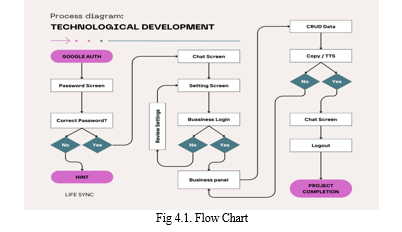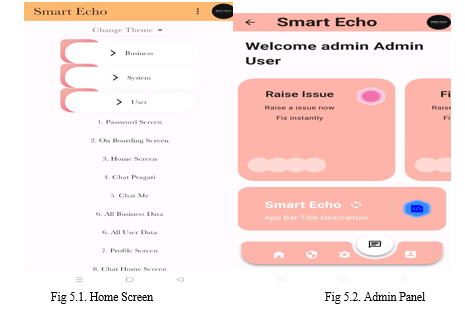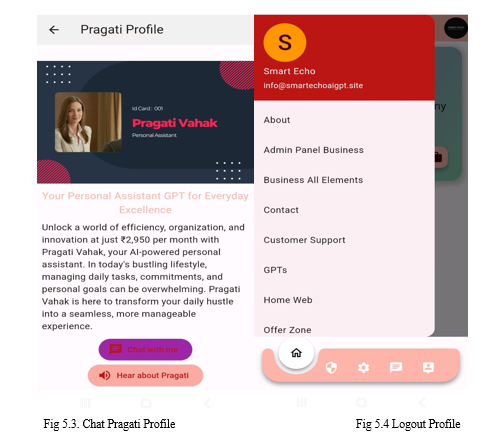Ijraset Journal For Research in Applied Science and Engineering Technology
- Home / Ijraset
- On This Page
- Abstract
- Introduction
- Conclusion
- References
- Copyright
Life Integrate: Unify Your Life, Simplify Your Success
Authors: Himanshu V. Taiwade, Mamta Barde, Shreyas Khadke , Yash Kurve , Yash Kullarkar, Himanshu Ukey
DOI Link: https://doi.org/10.22214/ijraset.2024.61934
Certificate: View Certificate
Abstract
Efficient management and organization of personal and commercial data is critical for reducing stress and increasing productivity in the fast-paced digital environment we live in. An inventive smartphone software called \"Life Integrate\" attempts to meet this requirement by effectively managing duties and merging different facets of life. The project aims to mimic the effectiveness of an AI personal assistant by bridging the gap between contemporary lives and efficient organizing. The software smoothly distinguishes between personal and professional data by utilizing technologies like machine learning and natural language processing, which improves the user experience and efficiency. One to three clicks can easily share data with the app, which adds to its effectiveness and user-friendliness. Aiming to streamline processes, key features include real-time editing, interactive chats, speech-activated assistants, and contextual awareness. The project\'s emphasis on developing a personal bot that excels at data collection and generates intelligent ideas based on collected data exemplifies an intriguing combination of customization and artificial intelligence. With its 13 primary sub-tabs and extensive questionnaires for storing both personal and professional data, the app offers an approach to organization and management that is user-centric. Effective app development and deployment are ensured by the use of the Flutter and Dart platforms. In general, \"Life Integrate\" seeks to transform the information landscape, making it easier to acquire and use, and facilitating more enjoyable interactions between humans and machines. With this project, we hope to create a future in which people can easily incorporate technology into their daily lives, increasing productivity and lowering stress levels.
Introduction
I. INTRODUCTION
People constantly strive to balance the demands of their personal and professional lives in the fast-paced digital world. Identifying this ubiquitous problem, our flagship project, Life Integrate, is an attempt to close the gap between contemporary lives and efficient organization by taking cues from AI personal assistants. An inventive answer is provided by Life Integrate, which provides a unified platform that connects many facets of life and makes job organization simple. Life Integrate's primary goals are to increase productivity, lower stress levels, and simplify daily tasks by giving users an all-inclusive tool for managing their obligations. The application facilitates users' ability to manage their hectic schedules by distinguishing between personal and business data.
The growing demand for AI-driven chatbots, which improve customer happiness and optimize company operations, highlights the need for such a solution. Life Integrate aims to improve user experiences by incorporating virtual personal assistants (VPAs) into users' daily routines in a seamless manner, therefore simplifying complicated activities. This initiative promises to transform the landscape of information accessibility and use through an intriguing blend of personalization and artificial intelligence. We carried out a thorough requirement analysis that included user demands, functional requirements, usability, accessibility, maintenance, support, testing, and validation in order to achieve our goals. Utilizing state-of-the-art technologies, including continuous integration and deployment, machine learning, natural language processing, user interface integration, data storage, and management, Life Integrate was painstakingly designed to satisfy the changing demands.

The three primary tabs of Life Integrate architecture the Business, System, and User (USB) tabs allow for the easy organization and storage of personal and business data. With many sub-parts and 13 primary sub-tabs, the app provides a complete solution that is suited to a wide range of user needs. Furthermore, dependability and efficiency are guaranteed while developing apps with the Flutter and Dart platforms. To put it simply, Life Integrate is an innovative project that aims to change how people manage their hectic lives. The program claims to improve productivity, lower stress levels, and streamline everyday tasks by seamlessly combining personal and business data management. This will ultimately enable users to lead more organized and satisfying lives in the current digital era.
II. LITERATURE SURVEY
Artificial intelligence (AI) is becoming more and more integrated into daily tasks in today's digital environment. At the vanguard of this technology revolution are virtual personal assistants (VPAs), which provide revolutionary answers to the problems presented by contemporary lives. VPAs, also called personal bots, use sophisticated algorithms to communicate with people, understand their preferences, and help with different activities. This allows them to operate as a link between AI and human interaction. Numerous studies examining the capabilities and prospective uses of VPAs have been conducted as a result of the rapid evolution of these tools, which has piqued the interest of both scholars and practitioners. These studies have brought to light the many features and advantages of VPAs, such as their capacity to improve user experiences overall, expedite productivity, and simplify challenging activities.
In VPA research, data structure and differentiation are important areas of study. The need for effective data organization and management solutions has grown as people depend more and more on digital platforms to manage their personal and professional lives. In an effort to give consumers easy access to pertinent information while maintaining data security and privacy, studies have looked into a variety of strategies for differentiating between personal and business data inside VPA platforms. The literature has also focused on efforts to improve data exchange capabilities on VPA platforms. Scholars have put up inventive approaches to enable smooth exchange of data among users, utilizing cutting-edge technology like machine learning and natural language processing to enhance the sharing procedure.
Moreover, research has highlighted the importance of continuous improvement and adaptation in VPA development. As user preferences and requirements evolve over time, VPAs must possess the ability to adapt and learn from user interactions to provide relevant and timely assistance. Studies have explored techniques such as adaptive learning and contextual understanding to enhance VPA capabilities, enabling them to offer personalized recommendations and insights based on user behavior and preferences. In addition to technical advancements, research in the field of VPAs has also examined the ethical and societal implications of their widespread adoption. Concerns related to data privacy, bias, and the impact of AI on human interactions have prompted discussions on the responsible development and deployment of VPAs. Researchers have advocated for transparent and ethical AI practices, emphasizing the importance of considering ethical considerations throughout the VPA development lifecycle.
Overall, the literature on VPAs provides valuable insights into their potential to revolutionize the way individuals navigate their daily lives. By leveraging advanced technologies and innovative approaches, VPAs have the potential to enhance productivity, streamline tasks, and enrich user experiences in diverse domains. However, ongoing research is needed to address the remaining challenges and ensure that VPAs continue to evolve in a responsible and ethically sound manner.
III. PROBLEM DESCRIPTION
The abundance of personal and professional obligations in the modern digital age frequently overwhelms people, calling for creative solutions for smooth management and organization. To tackle this issue, Life Integrate provides a feature-rich mobile application that functions as an artificial intelligence (AI) personal assistant, bridging the gap between contemporary lives and efficient organization. The project's main goal is to address the following important issues:
- Complicatedness of Data Differentiation: As personal and professional domains merge, it gets harder to tell personal data apart from commercial data. The inability of traditional approaches to effectively distinguish and arrange these heterogeneous datasets causes confusion and inefficiency in the handling of tasks and obligations.
- Ineffective Data Sharing: Many of the applications in use today lack optimized methods for quickly and effectively exchanging data. Users encounter difficulties while trying to communicate important information to the right people, which impedes productivity and teamwork in both personal and professional settings.
- Absence of Personalized Help: Current applications fall short of offering individualized help based on user preferences and needs. Consumers frequently receive impersonal responses from digital assistants that are not very flexible, which reduces the effectiveness of these tools in meeting their specific needs.
- Security Concerns: Maintaining data security is crucial given the speed at which the digital ecosystem is growing. Users emphasize how important it is to put strict security standards in place and demand strong security measures to protect their personal and company information from breaches and illegal access.
- Integration of Cutting-Edge Technologies: Making use of cutting-edge technologies like machine learning (ML) and natural language processing (NLP) might be difficult. To guarantee the best possible functionality and user experience, careful planning and execution are needed to integrate these technologies seamlessly into the application's structure.
- User Experience Enhancement: Improving the user's (UX) experience means making the application's interface more accessible and easy to use. It is difficult to strike a balance between feature-rich functionality and user-friendly design; this calls for iterative improvement and the integration of user feedback.
- Technical Difficulty: Overcoming the technical difficulties related to coding, data management, and system integration is necessary to create a reliable and scalable program. The project requires knowledge of many programming languages and frameworks, which calls for ongoing education and adaptability to new developments in technology.
Taking on these complex problems requires an all-encompassing strategy that includes careful execution plans, creative design processes, and thorough requirement analysis. Life Integrate seeks to revolutionize how people manage their hectic lives by providing a solution that effectively blends efficient data exchange, individualized support, and personal and professional data differentiation. The project aims to usher in a future where human-machine interactions are not only effortless but enriching as well, ultimately boosting productivity and lowering stress in today's fast-paced world through the deft use of cutting-edge technologies and a user-centric design philosophy.
IV. SYSTEM AND METHODOLOGY
Life Integrate was developed using a methodical approach to handle the difficult problems of smoothly integrating personal and corporate data while guaranteeing effective management and simple data sharing. Utilizing cutting-edge technology, the technique used includes multiple stages, such as requirement analysis, design, implementation, and testing, in order to accomplish the project's goals.
- Requirement Analysis: To comprehend user demands, functional requirements, usability, accessibility, maintenance, and support requirements, a thorough requirement analysis was carried out in the first step. In order to determine the most important features and functionalities required for a successful life organization app, this meant getting input from stakeholders and potential users.
- Design: The system's three primary tabs—Business, System, and User (USB tabs)—were chosen based on the criteria that were determined. Every tab has a distinct function that makes it easier to store and arrange pertinent information. There are thirteen primary sub-tabs in the app: Finger Print Authentication, System Data, System Visuals, Password Screen, Onboarding Screen, Home Screen, Chat Pragati, Chat Me, All Business Data, All User Data, Profile Screen, Chat Home Screen, and so on.

3. Implementation: Using a range of technologies, including data management, storage, machine learning, natural language processing, and user interface integration, was part of the implementation phase. The Flutter and Dart platforms, which offered flexibility, scalability, and cross-platform compatibility, were extensively used in the development of the app
4. Data Storage and Differentiation: Life Integrate's primary feature is its capacity to successfully distinguish between personal and corporate data. In order to do this, the app offers distinct tabs for storing information on businesses, such as the name of the company, registration number, kind, founders or owners, contact details, and more. Similar to this, user-related information is kept under the User tab and includes customer ID, full name, gender, age, contact details, residential address, and employment. The clarity and convenience of access to pertinent information are ensured by this division.
5. Data Sharing: Enabling simple data sharing with just one or two clicks is one of Life Integrate's main goals. The application has user-friendly features that facilitate the sharing of both personal and business data, improving productivity and teamwork.
6. Testing and Validation: Extensive testing and validation were carried out during the development process to guarantee the app's dependability, functionality, and user-friendliness. To find and fix any errors or inconsistencies, testing techniques like unit testing, integration testing, and user acceptability testing were used. User feedback was also requested in order to continuously enhance the usability and functionality of the app.
In conclusion, the creation of Life Integrate required a thorough system and methodology that gave top priority to user requirements, effective structure, and smooth data exchange. The app seeks to close the gap between current lifestyles and efficient organization by utilizing cutting-edge technologies and a methodical methodology, ultimately changing how people manage their hectic lives.
V. RESULT AND ANALYSIS
Life Integrate was created and put into use in response to the urgent demand for a productive organizing tool that could easily combine personal and professional data and provide user-friendly sharing features. After several rounds of analysis and design, the project produced a solid application that improves productivity in today's hectic world and streamlines chores.
The capacity of Life Integrate to successfully distinguish between personal and business data is one of its major accomplishments. The application utilizes cutting-edge technology like machine learning and natural language processing to automatically organize and store data, making it simple for users to access and manage their information. This distinction permits effective access to data pertaining to business while guaranteeing the privacy of personal information.
The user experience is greatly improved by the introduction of interactive conversation elements and speech-activated assistants. Voice commands enable hands-free operation and smooth task management for users interacting with the program. Furthermore, real-time editing features let users quickly update their data, guaranteeing that the information is correct and current.

The core of Life Integrate's functionality is effective data organization and storage. Based on user choices and usage habits, the app intelligently organizes data using smart classification and adaptive learning algorithms. This increases productivity and lowers stress by making sure people can find and get the information they need with ease.
The addition of one-click data sharing functionality to Life Integrate marks a noteworthy development milestone. With only a few clicks, users may share their data with friends, family, or coworkers, doing away with the necessity for laborious sharing procedures. This tool encourages user participation and communication, in addition to saving time.

Life Integrate excels at providing a user-friendly interface that meets the needs of a varied user base in terms of usability and accessibility. Users can navigate and use the app's different functions with ease, thanks to its intuitive design and layout. To further improve ease and usefulness, the app's cross-platform interoperability guarantees that users can access their data from any location at any time.
The fact that Life Integrate was successfully implemented shows how artificial intelligence has the power to revolutionize how people plan and govern their lives. Through the seamless integration of personal and corporate data, the app provides a comprehensive solution that boosts efficiency, lowers stress levels, and simplifies daily tasks. In the future, more research and development work can concentrate on improving the app's functionalities, adding new features, and connecting with a larger user base. All things considered, Life Integrate is a big step in achieving the goal of AI-powered personal assistants that enhance and streamline people's lives in the digital age.
Conclusion
A. Conclusion Life Integrate provides a complete solution to easily arrange personal and corporate data, which is a huge step forward in tackling the issues of modern lifestyles. By creating this cutting-edge application, we have effectively closed the gap between the needs of modern life and technological capabilities, simulating the effectiveness of an artificial intelligence personal assistant. Utilizing cutting-edge technologies like machine learning and natural language processing, Life Integrate not only distinguishes between personal and professional data but also makes effective sharing simple, requiring just one to three clicks, which increases user productivity and lowers stress levels. The key to Life Integrate\'s success is its capacity to meet consumers\' changing needs in the fast-paced world of today. The software provides an efficient and easy-to-use user experience with features including interactive discussions, speech-activated assistants, and real-time editing. Additionally, users can easily retrieve pertinent information thanks to its contextual awareness and intelligent classification skills, which streamline everyday routines and improve how people manage their busy lives. B. Future Scope Even though Life Integrate is a noteworthy accomplishment in the field of corporate and personal organizing, there are still many opportunities for research and development to expand on its potential and effect in the future. Adding more AI-driven capabilities to the app to improve its functioning is one possible direction for research. Predictive analytics capabilities, for instance, might allow Life Integrate to anticipate user needs and offer proactive recommendations or reminders, thereby increasing productivity and efficiency. The app\'s user interface and user experience design both have room for improvement in order to guarantee easy navigation and use for a wide variety of users. Insights could be gathered, and the app\'s functionality and performance could be iteratedly improved based on user needs and preferences by implementing user feedback methods. Future studies may also look into how Life Integrate might work in conjunction with other online services and platforms, like email clients, project management software, and calendar apps, to offer a more comprehensive and integrated approach to organizing one\'s personal and professional life. Further research into the usage of cutting-edge technologies like blockchain for improved data security and privacy could strengthen the app\'s security features and increase user confidence. In summary, Life Integrate offers a viable approach to addressing the issues associated with contemporary life organization. There exists significant room for additional research and development to augment its functionalities and influence, which could ultimately revolutionize the way people manage their hectic schedules and augment their general well-being and productivity.
References
[1] Among those included are Hedin Beattie, Lanier Watkins, William H. Robinson, Aviel Rubin, and Shari Watkins. 2022: AI Chatbot Bias Measurement and Reduction. Pages 117–123 in IEEE International Conference on Assured Autonomy (ICAA) 2022. [2] Keep in Mind the ABCs: Assessing the Current Status of Chat-Oriented Dialogue Systems 2022, James D. Finch, Jinho D. Choi, and Sarah E. Finch [3] How-to guides for building open-source chatbots Mr. Stephen Roller, Da Ju Naman Goyal Emily Dinan Williamson, Yinhan Liu Shuster, Kurt, and Mary Jing Xu Myle Ott Eric M. Smith, Mr. Y-Lan Boureau, is a French national. 2021 Weston Jason [4] Automated Assessment and Control of Open-Domain Discussion Platforms Joao Sedoc ?2, Luis FernandoD\'Haro 33, RafaelBanchs 44, ChenZhang 11, AlexanderRudnicky 55, 2021 [5] Sarah E. Finch and Jinho D. Choi. 2020. A thorough examination of existing evaluation procedures in the direction of a unified dialogue system evaluation. Proceedings of the Special Interest Group on Discourse and Dialogue, 21st Annual Meeting, First Virtual Meeting, pages 236-245. The Association for Computational Linguistics is known by its acronym, ACL. [6] Moving Towards an Open-Domain Chatbot with Features Similar to Humans Luong, Minh-Thang; Daniel Adiwardana Daniel R. Noah Romal and Jamie Hall Fiedel Thoppilan Zi Yang Apoorv 2020 Kulshreshtha Le Yifeng Lu Quoc V. Gaurav Nemade [7] HHH: An Online Medical Chatbot System Based on Knowledge Graph and Hierarchical Bi-Directional Attention, Qiming Bao, Lin Ni, and Jiamou Liu, 2020. [8] Stacked DeBERT: Text Categorization With Partially Available Data Cunha, Minho Lee 2, and Gwenaelle Sergio 1 will be born in 2020. [9] Among the people who have contributed are Mike Lewis, Yinhan Liu, Naman Goyal, Marjan Ghazvininejad, Abdelrahman Mohamed, Omer Levy, Ves Stoyanov, and Luke Zettlemoyer. Pre-training for natural language generation, translation, and comprehension using denoising sequence-to-sequence in 2019.AnarXivpreprintisarXiv:1910.13461. [10] Asma Ghandeharioun, Craig Ferguson, Noah Jones, Gata Lapedriza, Judy Hanwen Shen, Rosalind W. Picard, and Natasha Jaques. In 2019. Self-play is used to approximate interactive human evaluation for open-domain dialog systems. Advances in Neural Information Processing Systems.
Copyright
Copyright © 2024 Himanshu V. Taiwade, Mamta Barde, Shreyas Khadke , Yash Kurve , Yash Kullarkar, Himanshu Ukey. This is an open access article distributed under the Creative Commons Attribution License, which permits unrestricted use, distribution, and reproduction in any medium, provided the original work is properly cited.

Download Paper
Paper Id : IJRASET61934
Publish Date : 2024-05-11
ISSN : 2321-9653
Publisher Name : IJRASET
DOI Link : Click Here
 Submit Paper Online
Submit Paper Online

